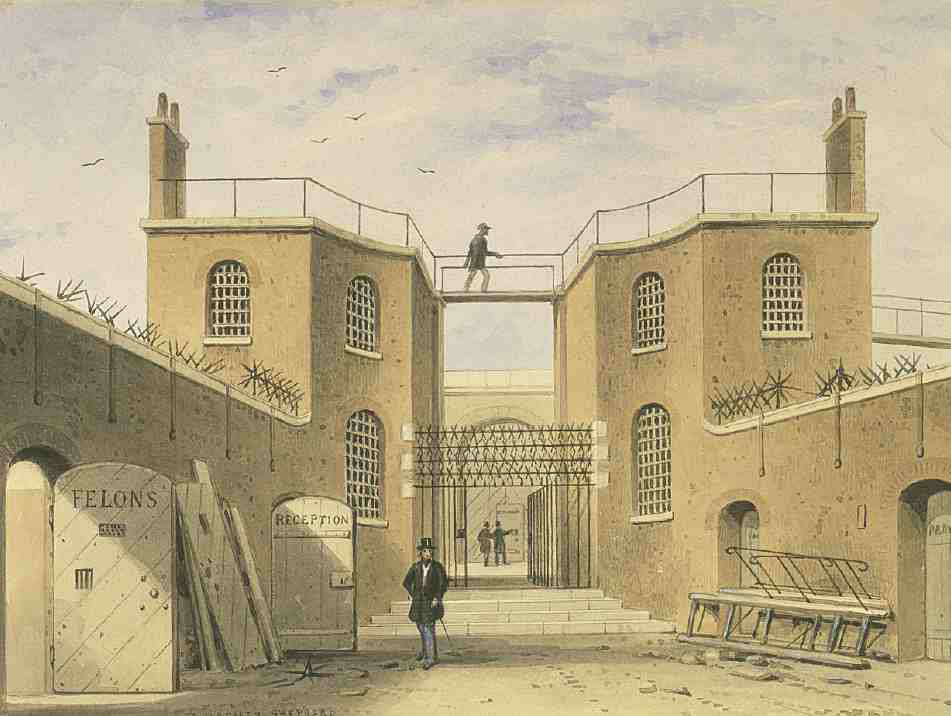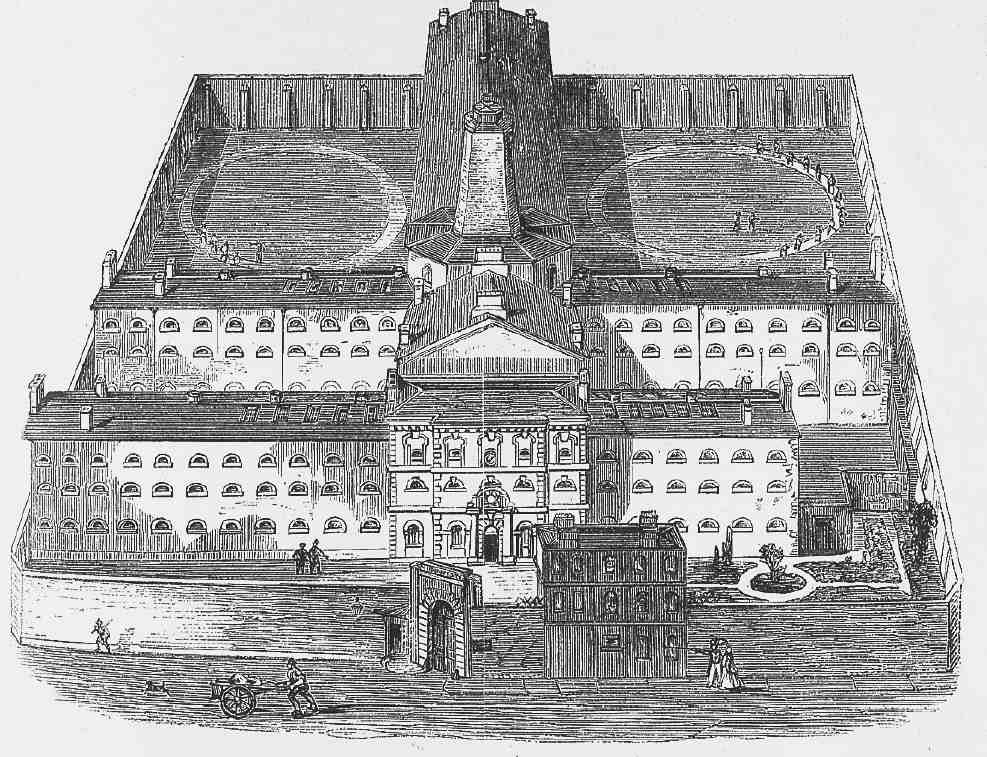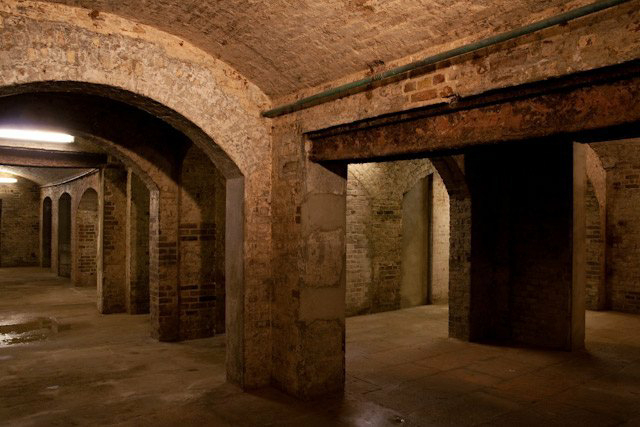Clerkenwell Catacombs
The Clerkenwell Catacombs are the bulk of what remains of the Clerkenwell House of Detention in London, England. The catacombs are an expanse of underground tunnels that would have been used as cells to hold inmates while they awaited trail. A number of prisons have stood on the site since 1616, but the catacombs date from 1844. The House of Detention was known for escape attempts, and one such attempt included a large explosion that killed a few and injured many others. Surprisingly though, this location is not said to be haunted by any stereotypical inmates; but rather by an old lady and a little girl, along with the lingering feeling of being watched.
History
A prison has existed on the site since 1616, with the property for the prison being aquired in 1615. The first prison was called the 'New Prison' and also went by 'Clerkenwell Bridewell'. This prison was built to take on the overspill from the other city prisons, but did face its own problems as during 1665 more than half of its inmates died of plague. A workhouse was built on the site during 1663, and stood beside Bridewell on the north side. This workhouse was defunct by 1675 as it couldn't make enough income. As a result, when Bridewell burned down in 1679, the prison moved into part of the disused workhouse. A greater part of the building was leased in 1685 to Sir Thomas Rowe who used it as a county school for poor orphans. This school failed to survive Rowe's death in 1696, and by 1700 the school was let to the Quakers. The Quakers used it as both a workhouse and school for orphans, which led the location to be known as the 'Quakers Workhouse'.
During 1685, the same year Rowe had leased the workhouse, a second county prison was built south of the workhouse and Bridewell. This prison was also called the 'New Prison', and was rebuilt in 1774/1775 to the designs of the county surveyor, Thomas Rogers, who enlarged it. The burglar and thief Jack Sheppard and his mistress Bess Lyon both escaped in 1724 before the second prison was rebuilt. I've found that one of the prisons was destroyed by a fire in 1780 during the Gordon Riots, but I haven't found if this was Bridewell or the New Prison. The Bridewell prison and workhouse remained until the early 1800s when Bridewell became superseded by a new Middlesex House of Correction at Coldbath Fields; although I've found that Bridewell closed during 1794 and that it was demolished during 1818. With both the prison and workhouse closed, the sites were used as exercise yards and barracks during the war with France. During 1816, with the war over, plans occured to rebuild the New Prison on a much larger scale. This work was completed in 1818.
During the 1840s, the New Prison became both overcrowded and outdated with thirty to forty prisoners to a room in some areas. As a result, during 1845, it was decided that a new prison should be built that covered the whole area. William Moseley, the county surveyor at this time, designed this new prison which was built in 1846/1847 with Samuel Grimstead as its contractor. This iteration of the prison featured 287 cells. It was during this build that the tunnels and passageways were added. I've found that they date from 1844, so it's possible that the construction process could have started in late 1844, or early 1845, with the prison opening in 1847. The prison was known as the Clerkenwell House of Detention, along as the Middlesex House of Detention. People have also called it Clerkenwell Prison. It was used as a place for people to be held while awaiting trial, and was located on Bowling Green Lane; adjacent to the Middlesex Sessions House where prisoners faced trial.
The House of Detention wasn't as fearsome as longterm correctional prisons. Prisoners were forbidden to talk to one another, sing, or whistle, but they were allowed to wear their own clothes. Plus, food could be brought by friends and family members along with materials needed for people to continue with their jobs. To try and make the prison more feared, a severed head was apparently hung over the entrance. The female wing of the prison was extended with more cells at the western end during 1853/1854. During 1865/1867 an extra storey of cells was added to each of the three male wings, plus a house was built for the chief warden by the south-west corner of the boundary wall.
On the 13th of December 1867, there was an attempt to free two Irish republican prisoners. These two prisoners were Ricard (possible alternate spelling Richard) O'Sullivan Burke, and Joseph Casey. Burke was a member of the Fenian Society that wanted an independent Ireland, and was an arms supplier for them. This escape attempt involved a huge explosion to the boundary wall. Before the event, authorities had become aware of a potential plot due to a policeman outside the prison becoming suspicious of a man and woman who had been frequently talking the day before. Due to this, precautions were taken that included moving Burke and Casey to a more secure area of the prison.
The explosion occured at 3:45pm and has been compared to a discharge of artillery. It shattered nearby houses, damaging houses opposite the blast beyond repair, along with destroying over sixty feet of the north perimeter wall. It was heard for miles, and is thought to have caused between six and twelve deaths, many of them being civilians in the area. Sources differ on how many were injured with some saying fifty, and others saying over one hundred. This event is known as the 'Clerkenwell Explosion' and the 'Clerkenwell Outrage'.
No one successfully escaped from the prison following the explosion, and one culprit was captured; Michael Barrett from County Fermanagh. During the April of 1868, Barrett was put on trial with five others at the Old Bailey. Two of the defendants were acquitted by the judge and, after a trial which lasted for two hours and thirty minutes, three others were acquitted by the jury. Barrett was convicted of murder and hanged during the Tuesday morning of the 26th of May 1868. He was hanged outside the gates of Newgate Prison, and was the last man to be publicly executed here. Public hangings were banned three days after Barrett died when Parliament approved the Capital Punishment Amendment Act of 1868.
In the mid-1800s, the Clerkenwell House of Detention had an estimated 10,000 people passing through its gates each year and was London's biggest remand prison. During 1871, houses beside the House of Detention were bought so that the perimeter wall could be extended. A male cell block and detached infirmary were also added during this time. I've found a few possible dates for when the House of Detention closed. It seems it closed in 1877, or 1886, and was demolished in 1890. All of the tunnels survived the demolition, but some of the underground cells were sealed off only to be excavated recently. Most of the wall, along with the tunnels, and chief warden's house are the only parts of the prison to survive the demolition. I've also found the demolition occured in 1893, but I suspect the 1890 date to be the correct demolition year as a school was built on the site which opened on the 13th of December 1893.
The school was the Hugh Myddleton School and it operated until 1971. It was the London School Board's biggest and most expensive educational establishment, and was even opened by the then Prince of Wales. At the time this was the first time the school board had a royal opening for one of its buildings. During 1971, the school buildings became part of the Kingsway Princeton College until they were sold to Persimmon Homes in 1999. The buildings were then converted into offices and apartments. The catacombs were given a grade II listing on the 29th of December 1950. They consist of 9000 square feet of vaults, and are the venue for Clerkenwell Design Week. They've also been used as a filming location for a number of things including the film 'Sherlock Holmes' where they can be seen towards the end of the film representing tunnels beneath Westminster.
The tunnels were left abandoned after the prison closed until World War Two when they reopened as an air-raid shelter during the blitz. They were closed again after this purpose until they reopened in 1993 as a museum, however a different source has said it was during 1983 that they opened as a tourist attraction. Ghost tours occured within the catacombs during 1994, and the museum closed in 1999. Another source has said the tunnels closed to the public in 2000. The space has been hired for filming use since, as described in the above paragraph.
Hauntings
The Clerkenwell Catacombs boast a surprising lack of hauntings for an old site which has had a number of prisons above it. A tour guide who held ghost tours here has said they haven't experienced anything aside the feeling of being watched when no one is there. During 1996, however, one of the managers has said 'they genuinely believe that a lost child is wandering the dank maze of corridors and passageways'. They've also said 'children were imprisoned here and the anguish they suffered must have been terrible. Perhaps this little girl's grief has somehow impregnated the stone and some people are just sensitive to that sort of thing'.
Regarding the little girl, it's said that people hear her crying from the inner depths of the jail. There is also said to be an old lady that seems to be looking for something. Visitors would ask tour guides who this woman was, and if they offered to help the woman then she would just look up and fade away without giving a response. Visitors also reported seeing a shadow figure.
A 'very unpleasant' individual is also said to haunt the catacombs. This spirit apparently stalks women who wander alone through the tunnels. It is said a malevolent spirit is present who attacks women, but I haven't found if this is the same as the one who stalks women. Temperature drops and the sound of footsteps have also been experienced here. Plus, the museum sound system turned on without explanation. The Ghost Club team have investigated the location on a number of occasions with their first investigation occuring in 1995, their second occuring in 1998, and their third occuring in 1999. If you want to read more about their investigations, you can click the 'Ghost Club' link which is listed amongst the sources I have used.
Summary Of Hauntings
1. Old lady, looking for something, clear apparition, fades away
2. Little girl, sound of crying - inner depths of jail
3. Shadow figure
4. Unpleasant spirit, stalks women who are alone
5. Malevolent spirit, attacks women
6. Footsteps
7. Temperature drops
8. Feelings of being watched
9. Museum sound system turned on
My Thoughts
If I didn't believe everywhere was haunted, then I would absolutely believe this location wasn't haunted from what I've read. However, I do believe everywhere is haunted to some degree, and so I do suspect there is more to the Clerkenwell Catacombs than what has been discussed online. Either that, or this location serves as a strong case study towards spirits being unable to traverse levels of ground. The catacombs date from the mid-1800s, so if spirits can't traverse levels then that means the spirits here would be from the 1840s to 1880s time period; and that's being generous. Realistically, you're looking at about thirty years worth of prisoners who would have experienced these tunnels. So, if spirits can't traverse levels, then that makes the lack of reported hauntings here make sense.
If the building was still present, or if you investigated properties on the site, I suspect they could be very haunted due to inmates of the past. You may also have victims of the explosion present, but I feel that would depend on how much emotion occured around the time of the incident. I also feel prisoners who died of the plague could haunt this site, but I honestly don't know if they would haunt the catacombs as they didn't exist back then. Interestingly, a case study which contradicts this location is Aldwych Underground Station. The underground tube station was built on the site of a theatre, and it's said that one of the performers from the theatre haunts the station even though it's underground. This implies that spirits can traverse levels; however, perhaps she can traverse levels because the station existed in her lifetime.
Due to the speculation regarding spirits traversing levels of ground, this location will be tagged as a location of interest. Sometimes it's the locations that boast few hauntings which can be the most interesting case studies. Due to the location being underground, and mostly forgotten, I feel the online discussion about this location's hauntings is genuine. There is little potential for Chinese whispers to have occured here, and the location isn't a tourist attraction so there is little case for anyone adding to or dramatising the hauntings in some way. This is likely why there is so little information online about the hauntings here.
Thank You!
Thank you for reading to the end of this article! I was incredibly surprised at how few hauntings there are said to be here, but as said earlier, I feel that only adds to the importance of researching this location. It was also a surprisingly tough location to write about too given all the different buildings which have been located on the site, and how a few of them merged into one over time. I do hope that you found the article interesting though. I did enjoy writing about a prison which isn't said to be haunted by all sorts of negative spirits.
A special thank you goes to Damain, Nicolette, Kerry, GD, The Cornish Ghost Whisperers, Beardo Gets Scared, Starlight Phoenix Paranormal, Paranormal Penny Pinchers, the Australian Paranormal Society, Codegas Codex of Curiousity, Phantom Detectives LLC, and Shadow Walkers Paranormal Investigators for your continued support of The True Paranormal. If you want to follow The True Paranormal you can do so on Facebook, Tik Tok, Instagram, X (formerly known as Twitter), and Tumblr. You can also subscribe to The True Paranormal on YouTube, or directly to this website through the bar on the left which will give you email notifications. That bar also lists all of the links which will take you to The True Paranormal's various social media platforms. If you want to contact me about your own experiences, or about anything at all paranormal, you can email thetrueparanormal1@gmail.com
A Donations Message
At the moment I don't have any ads running on anything, and I intend on the blog always being free for everyone to view because I believe knowledge should never be kept behind a paywall. I do, however, still need an income in order to continue writing articles. If you would like to donate towards The True Paranormal, you can do so via PayPal. If you are interested, my username is Daniel Carr and my paypal email is danielcarr130913@gmail.com. If you donate, I will be sure to thank you across social media and in my articles. Anything donated is much appreciated.
Sources I Have Used
2. Canvas
3. Ghost Club
5. Londonist
6. On London
8. FYI
9. Buildington
10. On London: Jail
11. Historic England
12. The Prison
13. Conferences UK
14. Exploring London
15. Lisahistory
17. Mapotic
18. Layers Of London
19. World Accent
20. Currybet
22. All About London
26. Roots Chat
27. Financial Times
28. Londonist
30. Exploring London
31. NME











Another fascinating and thought provoking article, regarding spirits traversing levels, or not? My better half was certain that a ghost was walking upstairs behind her when she had a paranormal experience in a 'haunted' hotel in Glastonbury. It might be worth researching that as a location. GD
ReplyDelete